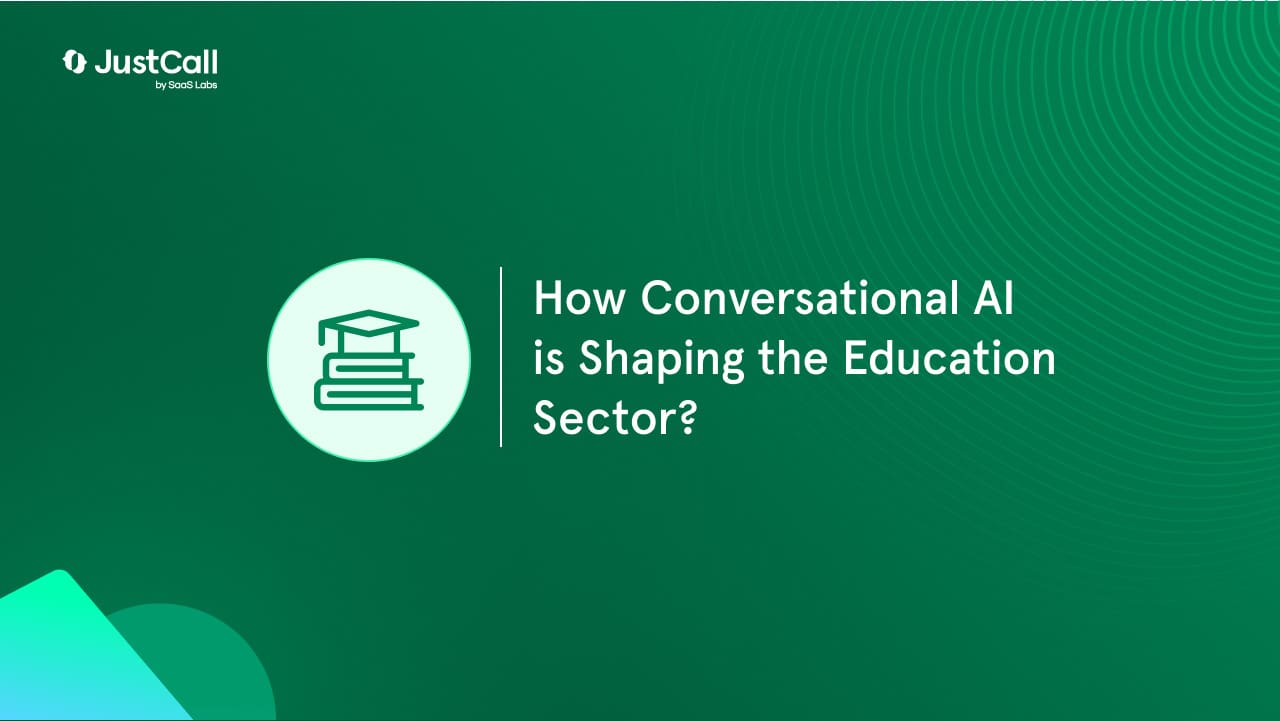Using AI in education has incredible transformative potential—only if used correctly. At the moment, there are a lot of ifs and buts when it comes to implementing AI in a field that’s intrinsically ethical and disciplined.
In this guide, we will look at the other side of things and explore how AI can—and is—revolutionizing the education sector without raising eyebrows.
Importance of AI in Education
Many view the role of AI in education as being restricted to conducting tests. However, there’s so much more that AI brings to the equation. Here’s the general perception of the potential impact of Vision, Voice, and ML & NLP technologies on education:
Speaking from a broader viewpoint, AI can help educational institutions to:
- Engage in AI-powered remote proctoring with integrity and speed and in a cost-effective manner
- Eliminate the need for having physical supervisors during the test, making execution scalable
- Alert and trigger warnings during instances of cheating
- Flag suspicious activity such as suspicious movement, presence of another person in the room, etc.
On the other end of the spectrum, AI-powered technology such as chatbots can help students:
- Engage in on-demand learning at their convenience, pace, and time
- Get their basic queries resolved, particularly ones relating to fees, admission, application status, and more
- Leverage an immersive learning experience by leveraging a variety of formats such as text, video, audio, and so on
- Access personalized learning recommendations that are based on critical data, such as how the student is progressing
As per experts, AI can vastly improve the language learning experience and assist in test-taking tasks:
Needless to say, AI can be applied to educational use cases in diverse ways (more on this in the upcoming sections).
AI in Education Statistics
Let’s get a bird’s eye view of the current adoption of AI in education. The data paints a promising picture:
- Competitive edge: For 15% of educational institutions, AI will be a ‘game-changer’ to the organization’s competitiveness
- Unprecedented growth: The market value of AI in education is predicted to touch US $20 billion by 2027:
Another study claims that the global AI education market will expand at a compound annual growth rate (CAGR) of 36% from 2022 to 2030. The real question here is: What’s driving AI adoption at this scale? Increasing public and private investment in EdTech AI and accelerated penetration of edutainment are the primary factors.
- Diverse use cases: AI is being used in education for 360-degree purposes such as learning platforms and virtual facilitators (45%), Intelligent Tutoring Systems (ITS), fraud & risk management, smart content, etc.
There’s an uptick in digital learning technology, which is further fueling AI adoption in education.
Achieve Contact Center Excellence With JustCall AI
Top-3 Challenges of AI in Education
Not all is positive when it comes to using conversational AI in education. Here are the top three problems with AI in education as per research:
- Solution cost and lack of skills: 57% of institutions view costs as the top challenge of adopting AI-enabled solutions.
- Lack of skills, resources, and continuous learning: Nearly 50% of organizations want to invest in AI solutions to close the employee skills gap.
- Lack of data strategy: Organizations are also lacking in setting up a data-driven strategy that stems from gaps in data governance policies, quality, and availability.
All these challenges can be mitigated if educational institutions have a clear understanding of how AI will benefit their business.
Tips and Best Practices for Using Conversational AI in Education
- Tip 1: When investing in generative AI, it is critical to understand the end use cases. Will your AI bot be able to don multiple hats—as a coach, a learning assistant, a tutor, or even a career guide?
- Tip 2: Think about whether you want to use AI for internal functions (such as streamlining operations between departments) or will you use it for external purposes, such as serving the end user’s needs.
- Tip 3: Train the teachers and staff to use AI to not only improve the student’s learning but also hone their own teaching capabilities. To enable a smoother AI adoption, organizations must get buy-in from the staff and make it a collaborative approach.
- Tip 4: Help students to understand the benefits of using yet another technology. Perhaps, the most significant advantage of using AI is to drive a change in student mindset from what to learn to how to learn.
In addition to the tips outlined above, follow these best practices when implementing AI:
- Define clear objectives: Clearly define the goals of using conversational AI in education. Do you want to enhance the learning experience and support students? Do you wish to boost teacher efficiency? Do you want to gather student data to improve educational outcomes? The better you define your AI objective, the more optimized your ROI will be.
- Focus on personalization and adaptability: If your AI does not have the capability to deliver personalized learning experiences that are tailored to each student’s needs and learning pace, it is already a failure. The bar for AI adoption in EdTech is high–both students and teachers expect to use tools that can adapt to responses and offer contextual content in real-time.
- Create an immersive experience with natural language processing (NLP) capabilities: There’s a reason why most companies are investing in ‘conversational’ AI today. This technology can understand and respond to prompts from students. This allows for more engaging and interactive conversations.
- Don’t forget about accessibility and inclusivity: If you want to deliver a global learning experience, ensure that the conversational AI platform is accessible to all students, including those with special needs. To enable this type of learning, integrate different learning modalities and formats within the tool so as to accommodate the needs of diverse learners.
- Set clear communication of AI’s capabilities: As a thumb rule, set realistic expectations for what the AI can do. Remember that it is a tool in the end, so your students and educators should understand the limitations of the system and intervene when necessary.
- Focus on data privacy and security: Prophecies for the doom of AI are everywhere, and the biggest culprit is concerns surrounding student data. If your student’s sensitive data is not handled with utmost care, the tool will do more damage than good. This is why it is crucial for organizations to ensure compliance with data protection regulations, safeguard student information at all costs, and be transparent about data usage.
- Ensure regular updates and improvements: It is also critical to continuously update the AI system so that your students and teachers don’t end up using legacy versions. This can–and will–affect functionality as well as accuracy. You must also strive to gather consistent feedback from users to identify areas for improvement and pivot as needed.
- Think about integration with existing educational tools: A seamless learning experience is built on using well-integrated systems. If the conversational AI system is not compatible with your existing educational tools and workflows, you risk performance issues.
- Factor in ethical considerations: Educational organizations that want to truly benefit from conversational AI must prioritize student well-being. So, for starters, do not use AI for assessments or grading without human oversight. At the current moment, AI tools are not foolproof and can produce biased results.
Impact of AI in Education: 4 Engaging Use Cases
No one can deny the potential of AI in education. When used in conjunction with irreplaceable human teaching, AI can offer explosive benefits for teachers, students, and the EdTech organizations at large:
1. Personalized Learning Recommendations is Possible with AI
Stanford researchers developed an AI program that offered 80% accurate recommendations to students, and the tool reportedly presented the same personalized recommendations as the human expert.
Leading learning platform Coursera is all set to launch a generative AI chatbot called “Coursera Coach,” which will help students to:
- Get personalized learning assistance
- Iron out their doubts in real time
- Build customized quizzes and summarize courses
2. Mapping Out a Student’s Learning Can Take Center Stage with AI
India’s biggest EdTech platform, Byju’s has launched three AI models: BADRI, TeacherGPT, and Math GPT. The platform wants to understand students’ learning patterns on a more granular level—making conversational AI take on a more predictive role in this case.
The AI model will gather real-time feedback on student performance so that the teachers can deep-dive into each student’s performance and improve their learning levels. Think of it this way: Two students will learn the same topic but in different ways depending on their learning behavior!
The biggest takeaway here is that the EdTech major wants to leverage AI not to replace teachers but improve organizational efficiency. Conversational AI can take over routine tasks and leave time for teachers to focus on other core tasks. Plus, the efficiency that AI injects into the organization has immense scope to trickle into the bottom line and boost profits.
3. Tutoring for Learners and Assisting Teachers: The Conversational AI Model That Works
NGO Khan Academy has developed an AI-powered guide, “Khanmigo:”
This AI-powered chatbot aims to drive one-on-one tutoring for students to boost:
- A deeper understanding of the subject
- Student confidence and empower them
- Clarity across topics and subjects
- Creativity as a tool can mimic a writing coach and offer prompts for writing, debating, etc.
Additionally, the tool has been built, keeping the teacher’s best interests at heart as well. Using AI-guided lesson planning, teachers can improve their teaching and gain insightful student feedback.
Instead of shying away from using AI or straight-out banning it, the Newark Public School (USA) is enlisting the services of the Khanmigo tutoring bot and maximizing student learning.
4. Conversational AI can Address Basic Student Queries
Georgia Tech leveraged the services of a virtual teaching assistant, Jill Watson, to assist with its Online MS in CS Program (OMSCS). Launched way back in 2015, when AI technology was restricted to movies and Sci-Fi, Jill became a worldwide phenomenon:
- She answered routine, frequently answered questions that crept up within the online discussion forum
- Her accuracy rates were off the charts (90%) with great authenticity, as students could not attribute Jill to being an AI agent!
- She has worked with 50 human TAs and has interacted with about 1500 students
- In her current capacity, Jill automatically answers one-third of administrative questions about assessments in the class (think: assignments, projects, and examinations)
In addition to the use cases above, AI is also being used to:
- Predict and assess students that are at risk of failing
- Improve language proficiency and help students learn other languages faster, as Edwin did for 800,000 students across Korea, Latin America, and Japan
- Make administrative tasks simpler and help teachers grade assessments at a faster pace
What is the Future of AI in Education?
Whether it’s keeping a (virtual) eye on remote candidates or driving scalable tests, AI is eliminating the geographical barriers quite literally to make education more global.
Even Bill Gates believes that AI can level the playing field for students, with chatbots assisting students in helping them learn to read and write. Plus, they can offer private tutoring to students who didn’t have the requisite resources or support—until now.
Even in the current economic climate, investing in conversational AI is doubling up to be a smart move as the chatbots of today are increasingly becoming smarter and more contextual, leading the way in on-the-fly learning.
The takeaway: EdTech organizations must embrace a ‘technology and teacher’ mindset as opposed to viewing it as technology versus teacher-driven learning. This technology, if implemented authentically, can benefit every stakeholder within the education system.
AI has entered the classroom and is passing with flying colors.












